#its on bristol paper
Explore tagged Tumblr posts
Text

#SORRY ITS BLURRY school library scanner was too small 😔#its on bristol paper#hehehe#anyways#xeb post#xeb art#portal 2#wheatley#wheatley portal 2
21 notes
·
View notes
Text
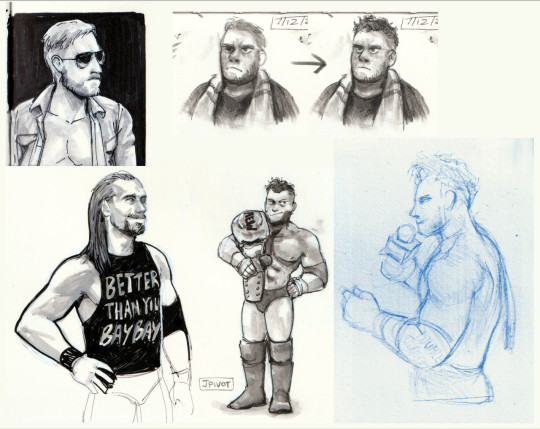
went to the art store last last weekend and of course picked up some new items. tested them out by drawing wrestlers on (incompatible) sketchbook paper. i didnt want to digitally edit any of these but i caved specifically on that topmost mjf because i really didnt like it lmao. included the before/after at least
#wrestling#traditional art. aka: ''oh no! the consequences of my actions!''#im a big dummy i shouldve bought another black pen because as it turns out all my black pens are old and dying UGH i need to throw them out#anyway i got:#a replacement n3 copic (my set has had an awkward gap in it for YEARS since i lost my last one)#a curiously opaque gray brushpen (karin decobrush. i used it on that cole)#water soluble pencil (oh... you can not erase this after you get water involved. lol)#non-photo blue pencil (lives up to its name. very difficult for it to show up on a scan. i digitally recreated it up there)#woodless graphite pencil (cool in theory but im extremely afraid of dropping this and shattering it -_-)#i also bought some PROPER watercolor paper and bristol. will i be too coward to use it??? stay tuned#ah frick i shouldve bought some like. fixative spray or something. these pencils are gonna smear over time. o well
24 notes
·
View notes
Text

#screaming into a paper bag#local man shocked that he has to work almost every day again because he works in a very busy area and not a dead mall#ughhh my last semester of 🙄COMMUNITY COLLEGE🙄 starts next week#its only 3 classes but theyre all boring and i dont give a shit about them#none of them even art related...... when my degree is an associates in art............#i hate this city#lives in a major city#anyways i wanna draw and do fun stuff but i come to work tired and want to instantly go to bed#and work is always packed so i dont even have time to THINK about being creative#moving to bristol to work for a*rdman pleaseeee manifest with me guys#i just want an art job aaahhhhh pleaseeee why is it only fuckass graphic design in my city#two paths for an artist in ch*cago#graphic design at a marketing firm#biography comics that you sell at the local consignment shop while you work at said shop#SIGHHHHH#anyways going back to drawing#bought some oven bake clay so i am pondering my choices
1 note
·
View note
Text
heres MY rambly black sails analysis for the day, after watching the show twice in as many months i wholeheartedly believe in the "long john silvers quote unquote missus in treasure island is max, not madi" theory
the most obvious thing, as others have pointed out, is that in treasure island long john silver runs an inn with his wife, a black woman, in bristol, which is absolutely not madi behavior-- i cannot imagine madi would take him back in the first place much less move with him TO ENGLAND-- but IS maxs exact area of expertise. but theres so many other things that cement it for me
as early as episode 2, max tries to convince eleanor to buy out the inn and run it together with her when england takes nassau back. this is her dream-- to share power over her life with a woman she loves, free of the pressures of the outside world. (youll note this also happens to be silvers dream for himself and madi. the parallels)
in season 4 shes faced with the suspiciously similar option to take a husband to be the face of her business, completely on paper, for the sake of the public eye. and she refuses! she doesnt want to give a man that kind of power over her. not only that but she desperately wants to retain some kind of truth in her identity-- she admires anne for her honesty, her courage. these are things she can rarely afford to express. in refusing a marriage of convenience, she asserts her autonomy.
But. black sails tells us over and over again that an oppressive society will always find ways to batter down these private boundaries. there is no island safe from colonial rule. mirandas peaceful house in the interior is burnt to the ground. the maroons are forced to accept a freedom that comes at the price of abandoning those still enslaved and taking part in their continued subjugation. the things it takes to make these spaces are terrible, and unsustainable, and when it comes to being gay in the 1700s there is a tightrope to walk between privilege and privacy, one that destroyed flint and the hamiltons, thats even narrower to max as a self-made woman of color.
given all that, i do not believe she can girlboss her way out of her circumstances no matter how many lessons she took from what happened to eleanor. nor do i think the show believes it. i think the political-marriage-offer plot point is another illustration of that theme-- maxs desire, and silvers desire, to build a warm, happy room in the middle of the imperial machine, without meaningfully striking out against the machine itself, is destined to be futile no matter how strong they are as individuals.
max and silver are mirror images of one another. each of them is essentially the narrator of one half of the story. it is absolutely agonizing how BOTH of them tried to convince their lovers to abandon their ambitions, to settle for a quiet life with them, and in doing so saw that relationship destroyed by their own fear of an uncertain future....
....And its even MORE agonizing to imagine them finally securing the trappings of a domestic life... but without the love. and they know the love was what mattered! theyre always going to know!!!
it bookends PERFECTLY with their alliance at the start of the series. theyre right where they started, trusting no one, pretending to be humble and harmless, planning to steal the EXACT SAME TREASURE, except now theyre 50 years old and jaded and bitter and both pining after their lost loves. silver probably pictures madi whenever he tells people about his wife. when he and max have time to themselves they talk solely about finances and nothing else. its honestly impressive how miserable this is for every single person involved. im losing my mind
752 notes
·
View notes
Text

Hey since its the holidays and my birthday month maybe you'd want to buy an original page from me! The pages are black and white inks on bristol paper and the available ones are shown above. Its $300 for one page and $400 for two.
If you’re interested shoot me an email at [email protected]
Thanks! 💙
146 notes
·
View notes
Text

sum marker art. Working on a final version on bristol paper.
still no clue whats up with the tumblr app for iphone. I cant make any posts for some reason. Button just straight up doesnt work. I have to post from my browser and its ultra lame. 😒
211 notes
·
View notes
Text
in addition to being prone to an obvious naturalistic fallacy, the oft-repeated claim that various supplements / herbs / botanicals are being somehow suppressed by pharmaceutical interests seeking to protect their own profits ('they would rather sell you a pill') belies a clear misunderstanding of the relationship between 'industrial' pharmacology and plant matter. bioprospecting, the search for plants and molecular components of plants that can be developed into commercial products, has been one of the economic motivations and rationalisations for european colonialism and imperialism since the so-called 'age of exploration'. state-funded bioprospectors specifically sought 'exotic' plants that could be imported to europe and sold as food or materia medica—often both, as in the cases of coffee or chocolate—or, even better, cultivated in 'economic' botanical gardens attached to universities, medical schools, or royal palaces and scientific institutions.
this fundamental attitude toward the knowledge systems and medical practices of colonised people—the position, characterising eg much 'ethnobotany', that such knowledge is a resource for imperialist powers and pharmaceutical manufacturers to mine and profit from—is not some kind of bygone historical relic. for example, since the 1880s companies including pfizer, bristol-myers squibb, and unilever have sought to create pharmaceuticals from african medicinal plants, such as strophanthus, cryptolepis, and grains of paradise. in india, state-created databases of valuable 'traditional' medicines have appeared partly in response to a revival of bioprospecting since the 1980s, in an increasingly bureaucratised form characterised by profit-sharing agreements between scientists and local communities that has nonetheless been referred to as "biocapitalism". a 1990 paper published in the proceedings of the novartis foundation symposium (then the ciba foundation symposium) spelled out this form of epistemic colonialism quite bluntly:
Ethnobotany, ethnomedicine, folk medicine and traditional medicine can provide information that is useful as a 'pre-screen' to select plants for experimental pharmacological studies.
there is no inherent oppositional relationship between pharmaceutical industry and 'natural' or plant-based cures. there are of course plenty of examples of bioprospecting that failed to translate into consumer markets: ginseng, introduced to europe in the 17th century through the mercantile system and the east india company, found only limited success in european pharmacology. and there are cases in which knowledge with potential market value has actually been suppressed for other reasons: the peacock flower, used as an abortifacient in the west indies, was 'discovered' by colonial bioprospectors in the 18th century; the plant itself moved easily to europe, but knowledge of its use in reproductive medicine became the subject of a "culturally cultivated ignorance," resulting from a combination of funding priorities, national policies, colonial trade patterns, gender politics, and the functioning of scientific institutions. this form of knowledge suppression was never the result of a conflict wherein bioprospectors or pharmacists viewed the peacock flower as a threat to their own profits; on the contrary, they essentially sacrificed potential financial benefits as a result of the political and social factors that made abortifacient knowledge 'unknowable' in certain state and commercial contexts.
exploitation of plant matter in pharmacology is not a frictionless or infallible process. but the sort of conspiratorial thinking that attempts to position plant therapeutics and 'big pharma' as oppositional or competitive forces is an ahistorical and opportunistic example of appealing to nominally anti-capitalist rhetoric without any deeper understanding of the actual mechanisms of capitalism and colonialism at play. this is of course true whether or not the person making such claims has any personal financial stake in them, though it is of course also true that, often, they do hold such stakes.
539 notes
·
View notes
Text
How to Create Paper Cut-Out Reliefs: Tips and Techniques for Beginners
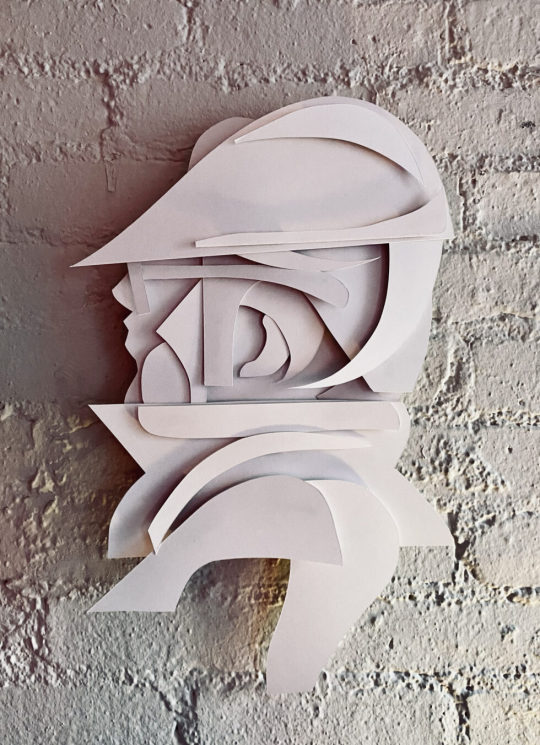
Back again with another lil' series of 2D wall relief paper cut-out forms. Both of the pieces below follow the same process and technique. Im really happy with the process and outcomes. Im working on animating them as we speak. I'll add them to this post later. My paintings inspire my drawings, and my drawings are inspired by those same forms found in my paintings. It makes sense that every so often I want to make those forms "pop out" and off the surface of a flat plane. Alas, it all starts with a quick sketch. See below, just a series of light loose free flowing lines take the lead, forward ->

Here we have a dude posing for a profile style portrait. Most likely, this is inspired by the NYC B-Boys from the years 1983 - 87ish. Either way, it's nostalgia for me. Once the sketch feels good, I'll break out the paper and x-acto knife. I keep telling myself that one day Ill work with another material other than paper for these works, perhaps wood or metal.. It will happen, I can foresee it for sure, hang in there. Im using a white bristol paper for the cut outs, I believe it is the vellum type and not the glossy, but either or will work just fine. I love to cut paper and the whole medium of paper art in general.
Paper cut-outs, also known as paper cutting or Kirigami, is a traditional art form that involves cutting shapes and designs out of paper. The history of paper cutting can be traced back to ancient China and Japan, where it was practiced as a folk art. The Chinese and Japanese would create intricate designs, often featuring animals, plants, and mythical creatures, and use them as decorations for festivals and special occasions. I always loved it and have felt inspired by these pieces.
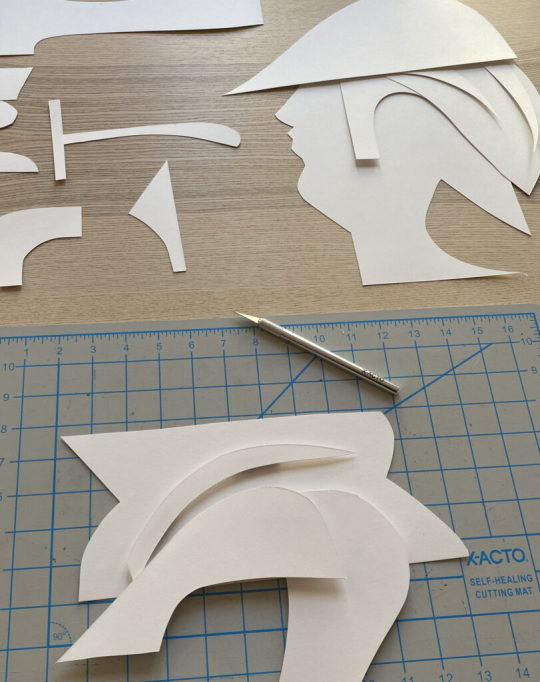
Using the sketch above, I apply the "map" of the shapes and forms that I see. Sometimes I redraw those forms on the paper that I will cut out, and sometimes I just "draw" with the x-acto knife to recreate the forms. Sometimes, it's a combination of both of those techniques. There is also a series of "out-take / byproduct" cut outs that do not make the final piece, those can be saved and used for the next piece, obviously!
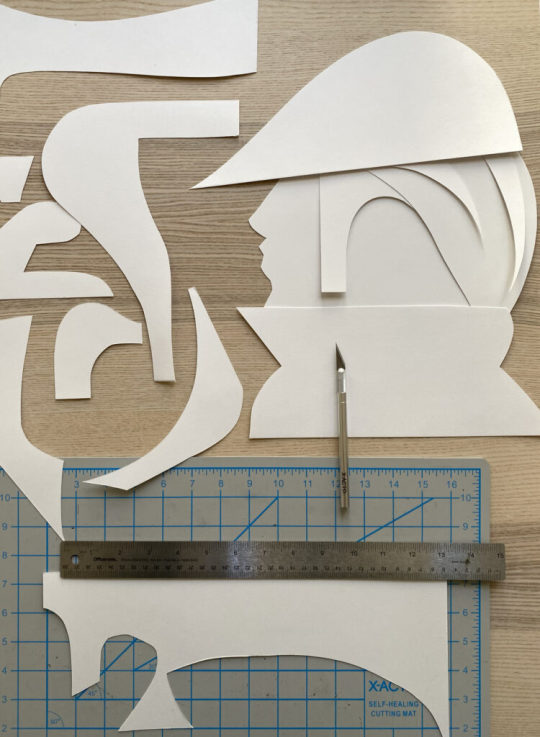
I layer the forms on top of each other to compose the arrangement as a whole, its fun to watch it all come together, in the next phase, you will need some kind of durable tape or you can make little paper forms that can be pasted to both sides of the forms as they stack, this will create the gauge and depth of the piece once it is placed onto the wall.
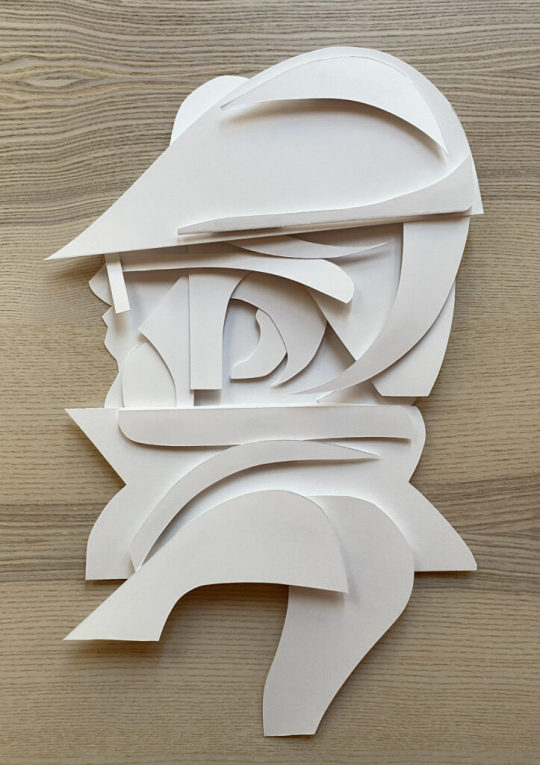
This is the final composition above, I love it! I used a roll of duct tape to make small cylinder forms that connect the pieces together, the piece as a whole comes "off of the surface of the wall" by about 1.5 - 2" inches - you can play with this a bit but keep in mind, the tape makes the piece heavier and it will want to comply with gravity :)

I hung the piece (also temporarily adhered via the same duct tape) for the photoshoot and to also get a good look at how it will function on the wall. I have an old painted fire place in my studio that is a great surface for hanging things, I love the contrast of textures between the bricks and the paper, as you know, the shadows will be super cool to see too.
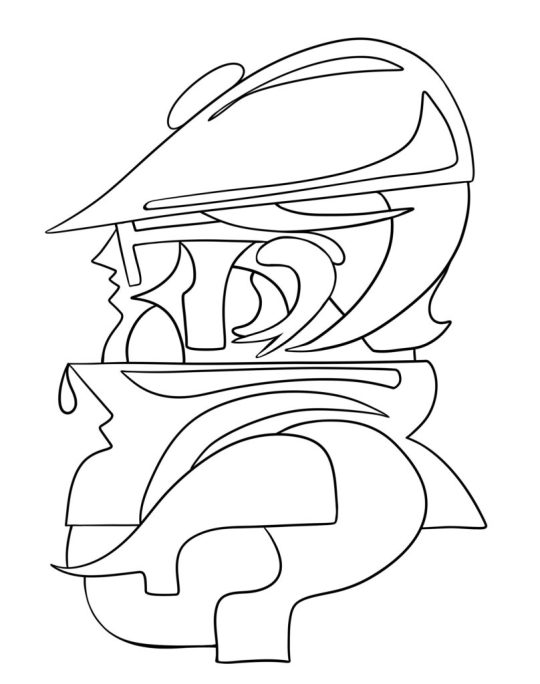
Once I had the whole piece constructed I took a few pictures of it. I immediately wanted a clean vector line drawing of the whole character. I brought the photo into adobe Fresco and used a vector brush to draw this lovely variation. This is how my brain works, I switch paths because I know they are really pipelines to the "next thing" that I will push this to, so forward we go.
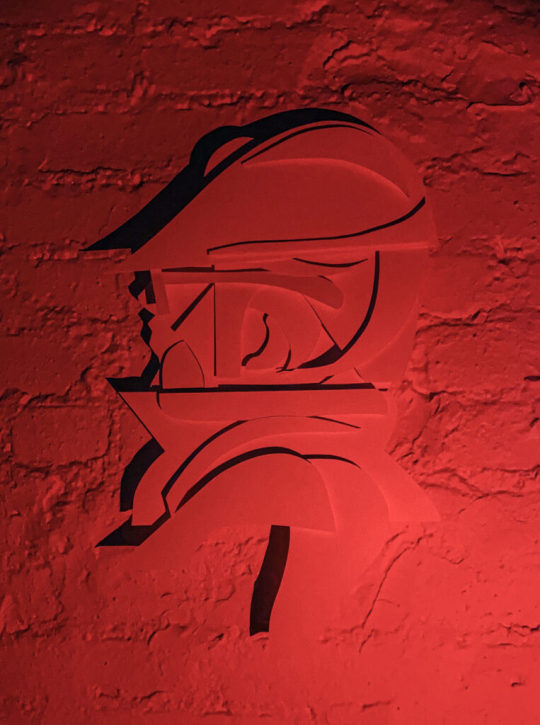
Then, it was light source and photo shoot time. Im not really happy with these picture as traditional "photographs" as I know I can do a much better job, but, as a series of "sketches" for a planned photo shoot, these will really help to make those plans a reality. I love neon colored lights. I have a bunch of them from various places and spaces that I found on the internet. Amazon has a great selection of flashlights with various colored light options. Get a few and play around with how the light can effect your work and the shadows that it creates. This is where the depth and gauge of your pieces play a role. The photos below are also a part of the same session, which all took place over a few days.
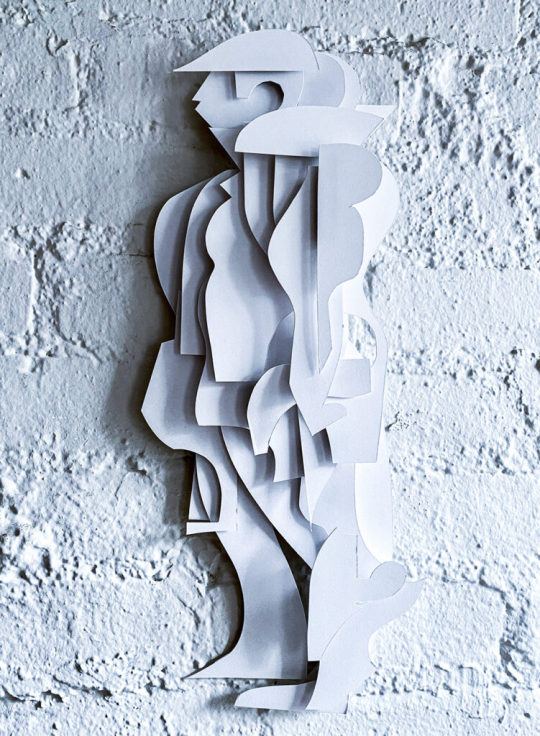
Here is another variation with a different character.. What do you think? Shall I make more?
#art#ryan seslow#ryanseslow#paper cut out#paper#paper art#2D design#2D#portrait#character design#graffiti#bboy#nyc#sculpture#paper sculpture
240 notes
·
View notes
Text
Also preserved in our archive
From September 2022. "Just a cold."
(Note: the most recent studies show the risk of cardiovascular disease, heart failure, and stroke can last upwards of three years in anyone who has had a covid infection. This older article was posted to emphasize that our knowledge of the risks isn't all that new or unknown, like some people like to pretend.)
By Christopher Sharp
As time goes by the world is learning more and more about the complications which come as a result of a COVID-19 infection; the risk of blood clots is just one of them.
Blood clots can occur at any time and cause a range of potentially fatal conditions such as heart attacks or strokes. Normally, their risk can be mitigated by improved cardiovascular health through regular exercise and a balanced diet. However, their risk can also be increased by other factors such as existing infections. One disease which can increase the risk of a blood clot developing is COVID-19. A recent study published by Health Data Research UK shows just how long that risk lasts for as the UK enters autumn.
The data was published in the Circulation journal by a group of researchers from the Universities of Cambridge, Bristol, Edinburgh, and Swansea who studied health records across the entire population of England and Wales between January and December 2020.
From this research they ascertained the risk of a fatal blood clot developing as a result of COVID-19 lasted for 49 weeks, almost a year.
Overall patients were 21 times more likely to have a heart attack or stroke in the first week after becoming infected with COVID-19. This figure dropped to just under four times more likely after four weeks.
As a result, they say their research suggests that the COVID-19 pandemic may have resulted in an additional 10,500 cases of strokes, heart attacks, and deep vein thrombosis, increasing the burden on the NHS at a time when it was at its most stretched.
With regard to the long-term risk of blood clots, the likelihood of a potentially fatal clot in the arteries dropped to just under one-and-a-half times between weeks 26 and 49 and just under twice as a likely for clots in the veins.
This isn’t the first time COVID-19 has been associated with an increased risk of blood clots; this paper adds to growing body of research on the long-term health impacts of even a mild case of Covid
Previous studies have shown COVID-19 can increase the risk of heart failure, heart attack, or a stroke by over 50 percent regardless of all risk factors. However, while these studies make for unnerving reading, the authors say the risk of a fatal clot as a result of COVID-19 remains low.
Professor Jonathan Sterne of the University Bristol said in a statement: “We are reassured that the risk drops quite quickly – particularly for heart attacks and strokes – but the finding that it remains elevated for some time highlights the longer-term effects of COVID-19 that we are only beginning to understand.”.
Subsequently, while the risk is low, this does not mean that health officials and governments can relax. While case numbers are low and the illness caused by Covid can be relatively mild, this doesn’t mean the virus isn’t still a threat.
Furthermore, although the virus is mainly problematic for the old and the vulnerable, this doesn’t mean young people haven’t or won’t be affected by the virus too, as multiple studies reveal as much from the latest research in the United States.
Meanwhile, Professor Angela Wood from the University of Cambridge said: “We have shown that even people who were not hospitalised faced a higher risk of blood clots in the first wave.
“While the risk to individuals remains small, the effect on the public’s health could be substantial and strategies to prevent vascular events will be important as we continue through the pandemic.”
One study, recently made available in the Radiology journal by the Radiology Society of North America, has found that COVID-19 can cause lasting lung damage in children and teenagers.
As this data suggests, this isn’t necessarily the case. The children and teenagers who recovered from COVID-19 showed persistent lung damage after undergoing an MRI scan.
Senior study author Dr Ferdinand Knieling said: “We conceived this study when the evidence for long- or post-COVID cases in adults was growing. This was also when the first patients with unspecific symptoms were seen in our department, and parents started to ask about an association with a prior infection.”
Dr Knieling’s department used a new MRI scanner in order to safely assess the damage done by COVID-19 to the young people affected, looking at changes in lung structure and function in 54 participants.
Despite the small study cohort, long Covid in children is a genuine problem. Data from the ONS (Office for National Statistics) published earlier this year found around 98,000 children in the UK suffer from the condition.
However, as those who have fully recovered may have experienced changes to their cardiovascular system, the number of children impacted could be much larger.
Dr Knieling added: “Persistent symptoms after COVID still cause diagnostic odysseys, and this is especially true for young people. Our findings illustrate that caring for these patients is a multidisciplinary challenge.”
Overall, alongside the blood clot research, this study demonstrates how far-reaching the COVID-19 virus will be even after the pandemic in question has ended.
Study links: www.ahajournals.org/doi/10.1161/CIRCULATIONAHA.122.060785
(The link in the article is broken, but I think this is the radiology article link) pubs.rsna.org/doi/10.1148/radiol.2020202543
#mask up#public health#wear a mask#pandemic#covid#wear a respirator#covid 19#still coviding#coronavirus#sars cov 2#long covid#covid is airborne#covid is not over#covid conscious
41 notes
·
View notes
Text
ShortBox Comics Member Interview: Violet Kitchen
Throughout the month of October, the Cartoonist Cooperative will be sharing interviews with members of the Co-op who have a new comic available at the ShortBox Comics Fair 2024!
NOTE: The Cartoonist Cooperative is not affiliated, associated, authorized, endorsed by, or in any way formally connected with ShortBox.
Today’s spotlight is Violet Kitchen and their new comic for ShortBox, Allodynia.
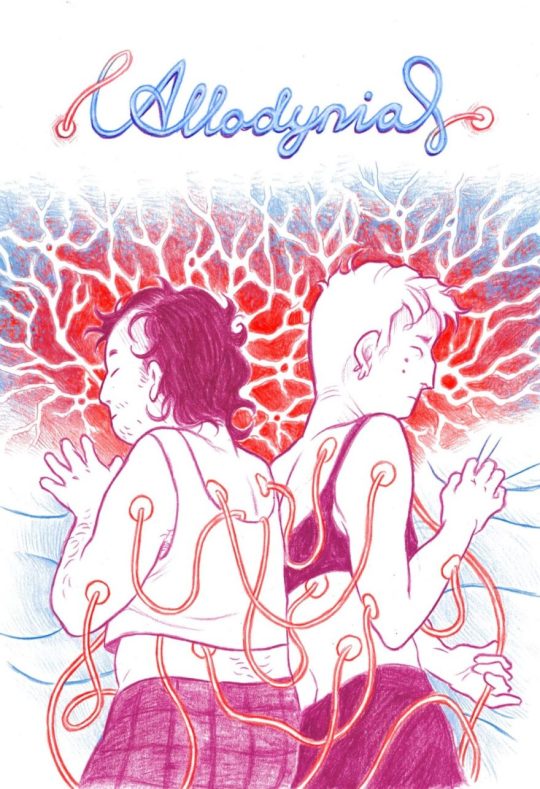
We’d love it if you could introduce yourself and tell us about your background in comics.
Violet Kitchen: I’m Violet, or Vi, and I’m a recovering hermit living in the wilds of Vermont! I started drawing comics pretty much as soon as I could hold a pen. I had a very specific spot at my family’s coffee table where I would sit with a sharpie and a stack of printer paper and crank them out obsessively.
After over a decade of hibernation, I rediscovered comics in my early twenties and over the past few years have thrown myself back into making them. I have a deep and abiding love for the small press scene and it’s coming to form the backbone of my life.
In addition to my personal practice, I’m a co-founder of the micropress Go Press Girl! along with my friend Rachel Bivens, and I work as a librarian at the Center For Cartoon Studies, where I graduated in 2023.
Tell us more about your new comic?
VK: Allodynia follows a young queer couple, Tess and Jules, through the changes in their relationship as Tess volunteers for an experimental and painful medical study at a local hospital.
Tell us about your creative process; how did you develop this comic and what are the steps you took to bring it to the final stage?
VK: This comic was unusual in that I never wrote a script. I had the general tone and outcome of each conversation in mind as I thumbnailed the story, but I wrote the actual dialogue in real time as I drew each page. I’ve never improvised to that extent before and it was pretty nerve-wracking!
I was partly inspired by Luke Kruger-Howard, who writes his webcomic Football America Dream as he goes along; the dialogue is the first thing he puts down, straight to ink, and the rest of each panel gets arranged around it.
In some other ways I adhered to my typical process. I thumbnail very loosely on Post-its that I redraw and rearrange until I’m satisfied with the layouts and story progression. Then I draw “pencils” in sharpie on printer paper, and lightbox over them onto Bristol with the final tool of choice, in this case a mix of 8B-10B graphite and colored pencils.
I really like inking the pencils and penciling the inks, because it forces me to be a little less precious both ways.

Read the rest of the interview HERE! And dont forget to check out the Shortbox Comics Fair to support these lovely creators!!
#cartoonist cooperative#comics#comic art#comic artist#cartoonist#comic recommendations#shortbox comics fair#sbcf#sbcf2024
19 notes
·
View notes
Note
Hii is there any tutorial on how to bind paperback books? All the tutorials I found of fanbinding from various sources are all hardcovers and it is not something that I can do right now! So I was wondering if there's some alternate options?
oh boy - i don't have any experience with doing paperback books but i did peruse the hive mind (AKA Renegade Discord) to see what resources people who do paperbacks use.
From what I can tell, most people in my bookbinding discord do a doublefan or lumbeck binding, however, this will require a bit of equipment like a press to hold your pages steady.
youtube
The videos and advice from people who've tried it make it seem a lil tricky to do since the glue dries fast, its difficult to ensure all the papers are glued and pages fall out etc etc. Another person recommended another video online for regular perfect binding:
youtube
I haven't watched this person's videos before, so wouldn't be able to comment on bookbinding technique etc. YMMV.
I personally still prefer to do sewn versions of books because the book is held together with stitching rather than glue and is more secure in that sense. if you have issues obtaining board, you could try the sewn-board binding, but use cardstock or bristol board instead of actual board? i've also done coptic style books where i've stitched cardstock onto the front and back as covers.
youtube
Hope this helps!!! apologies that this isn't my area of expertise so my comments on this will be a little limited.
If you'd like to ask some questions on the Renegade Bindery Discord and you're above 18, feel free to PM me and i'll send you the link to it! :)
#fanbinding#ficbinding#bookbinding#bookbinding asks!#final frontier publishing#bookbinding questions!
99 notes
·
View notes
Text
Welcome back to Potato's "How To Bullshit Sewing"
First I showed my concept, now we're going to measure and cut out the pieces!

So I'm going to vocational college for graphic design, so I need a bag to hold a lot of books and papers. My largest paper pad I've used so far is this Bristol Board, so that's what were going go use to measure about how big to make it!
First you take your largest item and lay it on the fabric, and draw the shape of the bag around it, remembering to have extra material for seam allowance, and "opps I fucked up and now the edges are all frazzled"
(I forgot to mention that the canvas and other materials I have is doubled, from when they cut it off the bolt, so you only need the cut out the outer material once if that's the case for you.)
It's likely I'll trim this down a bit later, but its better to have more than you need, then less that you have to go back and get.

Next, stack the stuff you need in it and either take a leftover piece of material or paper and mark how wide the sides need to be. I had some leftover canvas that was about the width of the stuff I had, so I used it as a starting point.

From the bottom of the material I marked where the top of the lenght was, pretty much just made a line where I the top corner was.

Here I marked the width of the bag, but unfortunately I didn't have enough material to have one continuous line for the whole bag. But, since this material is folded, I can just mark about the middle of the bottom and have two halves.

Next, the Tazer Pocket I want to add to throw side.
The one on my messenger bag was fine, that one I top sewed the folded edges closer together so it wouldn't be completely flat on the side, if that makes sense.
But this time we're making side seams so it doesn't go inside the bag a bit, if that makes sense also.
Repeat the steps like with the Bristol board, giving plenty of seam allowance and trimming room. This scrap price was perfect to use, and I had enough to also use it for the side seam.


I folded that material hotdog style and that looked to be enough for the side seam, so it's good enough for me! If it messes up later it can be a snack pocket lol.


Next, I want to make a drawstring bag on the opposite side for trinkets or chapstick or whatever the hell, so I cut out a piece that was a little bigger than the side of the bag, which looking now I'll likely trim a bit of the lenght off later.

Sooooo, I forgot to take a picture of makeing the front flap for the bag. Since I used up the 10 image limit of the post, I'll make a drawing of how I made that later.
Thank you for reading! I know it's not a very comprehensive tutorial, but it's fun so oh well! Maybe in the future I'll make a better post about it.
#sewing#sewing tutorials#sewing process#sewing project#bag#messenger bag#cottagecore#bag diy#sewing diy#tutorial#bad tutorial
7 notes
·
View notes
Note
For the art ask meme:
Favourite types of canvas/paper/etc?
WHITE BRISTOL BOARD PAPER MAKES ME HAPPY
I LOVE U SMOOTH BRISTOL BOARD PAPER THAT I SHOULD PROBABLY USE. But my dumb self goes “but i dont wanna ruin it”
BRUH its ART PAPER its MEANT to be ruined, and yet.

10 notes
·
View notes
Text
i hope you all spend a very good lesbian summer !! nina and lotte are !!
i draw "with two left hands" so i'm very self-conscious about my drawings, i know i'm not very good, especially compared to other much more skilled people on here but i ended up liking it quite a bit, it was really like in my imagination.
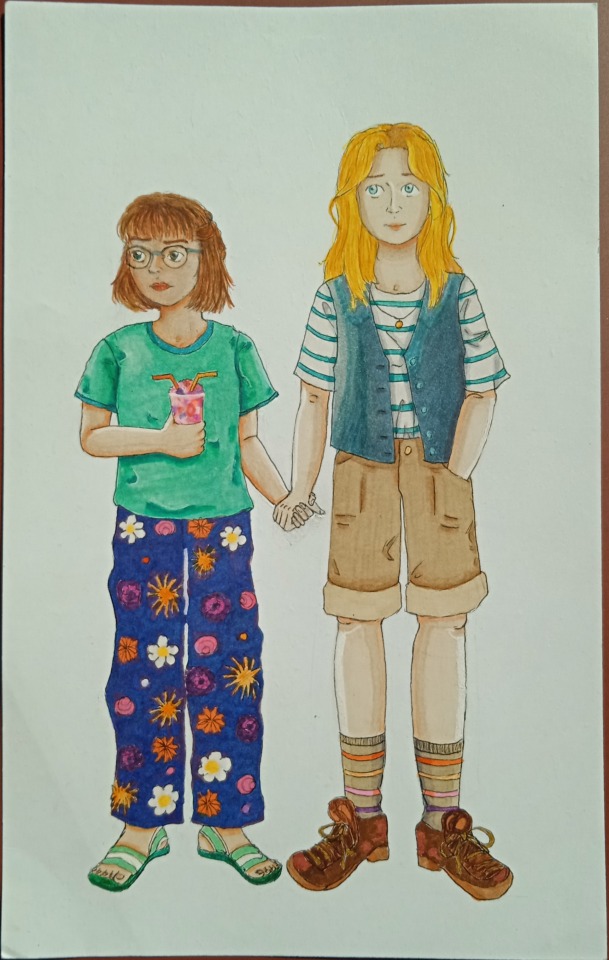
also notice the little lesbian flags : on the trousers' pattern, the socks and the granita and straws they share 🧡. also i love slowly butchifying nina (lotte's turn will come), it makes me very happy and her south of france fit is one of my favorite of hers as a butch myself and someone living in france. idk why tumblr gives the picture a worse definition.
below the cut is the scanned version + fuller pictures and what i used as well as what i liked doing the most.
so the paper is a bristol paper which means the drawing is rather small. i used different marker pens i gathered around the years as well as different types of regular pens to colorise it.
for nina's hair, at first i ranked the yellows i wanted to use from lighter to more orange. i colorised first with a pale yellow crayon base and then used my pens to get her haïr more and more darker.
also i wish i did better for lotte's face in terms of skin color but the final result is better than some versions that i came up with before.
what i like the most are : nina's skin and its shadows as well as her short, her t-shirt, the shadows in général, the granitas, the flowers and lotte's trousers blue color (i did it with a dark purple, then dark prussian blue markers and added a lighter dark blue since it was still a bit too purple).
the fuller picture + one with a slightly different lightning.


the scanned version i just did :
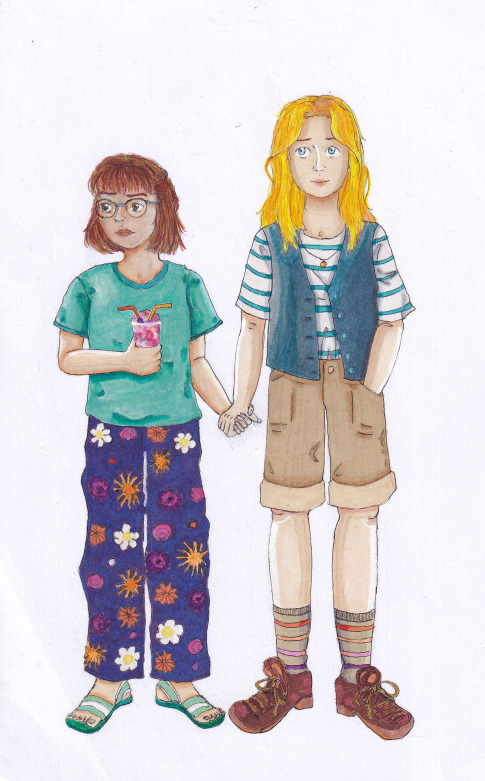
#also my background for the picture is my 6th volume of monster i bought wednesday <3 i'm sad just thinking about finishing the books though.#also i have a pair of similar trousers as lotte i just made the flowers a bit more lesbian flag :').#nina fortner#lotte frank#lesbian stuff#monster#naoki urasawa's monster#sophia talks#my art#traditional drawing#monster manga#monster anime#lesbian
42 notes
·
View notes
Note
Hola! Just dropping in to say I love your style so much! The looser look is done perfectly because your art still looks clean and cohesive and I didnt even start on the shape language- its *mwa* perfect!
So, on this, what software and brushes do you use? I know the tools don't make the artists but I can't help but look, point and go 'I GOTTA GET ME THAT'
Lotsa love! <3
hello! god, thank you for the kind words, that means a lot. im constantly trying to improve. your input makes me really happy 🥺 let me answer your question under the cut!
so i mainly draw in clip studio paint and magma.com. uh... the latter i actually dont really recommend unless you want to draw with other people. (its honestly not too bad, my only real gripe with it is that it only lets you undo like 10 times.)
unfortunately i dont have all the brushes i ever used on magma saved. ive played around with the settings a lot and even drew without pen pressure at times, rendering a lot of the brush's features useless. i'm gonna do my best to share as many as i can recall using:
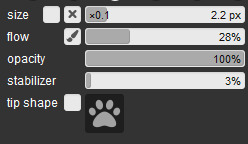
^ this one i used for the one i posted most recently (along with a simple big brush for the colored parts)


On clip studio paint i dont recall using any brushes other than the basic G-pen recently, which looks like this on my end:

Stabilizer is set to 0.
And though you didn't ask, as for traditional art, i've been drawing with an HB pencil on bristol paper lately.
I hope that's helpful!
13 notes
·
View notes
Text
@sarasa-cat this is too much for replies, lol, gonna do it old-school tumblrfailr style.
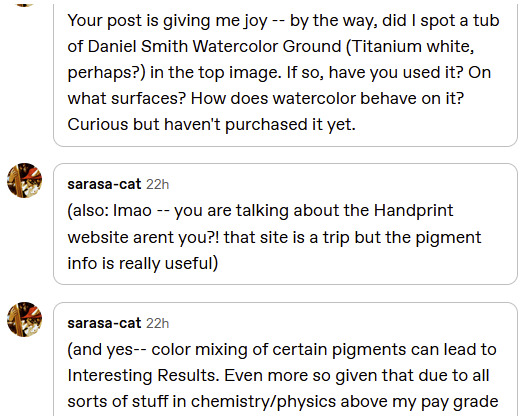
The amazing thing about color theory to me is that it gets into such complex math before you even get to the chemistry. What color space are we using? Are you sure? Can you actually show that? What's the light source? It gets beyond me fast, but I'm a spreadsheet slut and I can't resist the numbers. Trying to really understand perceptual color can drive you mad. Like, serious doubting-your-own-perception land.
The DS water color ground is transparent. I haven't tried it yet, but my thought was that I could print a sketch, seal it with acrylic medium, then add the ground, letting me get out of the horrible sketch-transferring process. I don't know if it will work, if I need the barrier acrylic, or what. It's also supposed to make a cold-press sort of texture, and I mostly do ink-lined work on hot press, bristol, or multimedia paper. (I am Not A Watercolorist, lol). When I finally experiment I'll report back!
...and yes. It's Handprint. I'm not surprised it's recognizable from the description, but its still cracking me up.
Now I'm taking what I learned from my watercolor dive and considering my acrylic collection (yes, I have too many media). It started out as nearly mirroring the oil paint palette I learned in college, but then I replaced things piecemeal based on 'what is available in the picked-over store', so it could use some help. Then there's the oils... two full sets, dating back to when I worked at an art supply store with a friend who was great at scoring samples from reps. I have unfinished oils on the wall crying at me.
12 notes
·
View notes